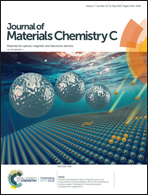Significant enhancement of responsivity of organic photodetectors upon molecular engineering†
Abstract
Organic photodetectors (OPDs) have been widely studied to achieve high performance for light detection. Photocurrent, a key parameter determining the responsivity of photodetectors, has rarely been investigated for enhancing the performance. Herein, three small molecules were systematically designed and synthesized for use as OPDs. Through the introduction of S⋯O non-covalent conformational locks and changing side chains, the physicochemical properties of the materials, especially the light absorption range and blend film morphology, were effectively tuned, leading to enhanced photocurrent and thus a higher responsivity (from 0.07 A W−1 to 0.29 A W−1 at −0.5 V bias), which is among the highest values for OPDs. The mechanism was systematically investigated with different techniques including ultrafast transient absorption, vertical phase segregation, and charge transport mobility, which helps to elucidate the differences of the photodetectors' performances. This contribution presents an efficient strategy to enhance the responsivity and sheds light on understanding the structure–property relationship of organic semiconductors for use as OPDs.



 Please wait while we load your content...
Please wait while we load your content...